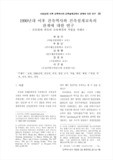

-
 * 본 문서는 배포용으로 복사 및 편집이 불가합니다.
* 본 문서는 배포용으로 복사 및 편집이 불가합니다.
미리보기
서지정보
· 발행기관 : 한국건축역사학회
· 수록지 정보 : 건축역사연구 / 20권 / 3호
· 저자명 : 배형민, 우동선, 김봉렬, 전봉희, 이규철
목차
1. 서론
2. 1980년대 서양의 건축교육과1990년대 이후 해외파의 등장
2-1. 김승회와 최욱의 건축과 교육배경
2-2. 1990년대 이후 한국 건축계에서 해외파의 등장
2-3. 한국 현대건축에서 파편
3. 잠재적 모더니즘(Latent Modernism)
3-1. 최욱의 한옥 연작과 체계
3-2. 김승회 건축의 파편
3-3. 건축역사, 건축교육, 그리고 건축설계
4. 결론 - 미지의 세계, 그리고 지식의 안과 밖
참고문헌
Abstract영어초록
The goal of this paper is to analyze the relationship between pedagogy and the emergence of contemporary Korean architecture after the 1990s. For this purpose, the paper deals with the education and work of two important contemporary Korean architects, Kim Seung Hoy and Choi Wook. Kim and Choi were part of a group of young architects that went abroad in the 1980s to study at the centers of architectural education in Europe and the United States. Through their education and work, the paper discusses the relationship among education, history, and design practice in architecture. During their studies at Michigan University and IUAV in Venice, they were commonly influenced by Colin Rowe through their studios. In the case of Kim Seung Hoy, he was introduced to the Beaux Arts logic of the analytique and esquisse through the teaching of Steven Hurrt, a disciple of Colin Rowe. Choi Wook took studios that involved formal analysis and comparison of Palladio and Le Corbusier. The paper further analyzes their works in Korea by employing the concepts of fragments and systems, ignorance and knowledge. The paper concludes that, in Korean contemporary architecture, fragments and systems, ignorance and knowledge, lie in the middle of ongoing creative process that must distinguished from the West, where architectural history provides an established tradition of systematic knowledge.참고자료
· 없음태그
-
자료후기
-
자주묻는질문의 답변을 확인해 주세요

꼭 알아주세요
-
본 학술논문은 (주)코리아스칼라와 각 학회간에 저작권계약이 체결된 것으로 AgentSoft가 제공 하고 있습니다.
본 저작물을 불법적으로 이용시는 법적인 제재가 가해질 수 있습니다. -
해피캠퍼스는 구매자와 판매자 모두가 만족하는 서비스가 되도록 노력하고 있으며, 아래의 4가지 자료환불 조건을 꼭 확인해주시기 바랍니다.
파일오류 중복자료 저작권 없음 설명과 실제 내용 불일치 파일의 다운로드가 제대로 되지 않거나 파일형식에 맞는 프로그램으로 정상 작동하지 않는 경우 다른 자료와 70% 이상 내용이 일치하는 경우 (중복임을 확인할 수 있는 근거 필요함) 인터넷의 다른 사이트, 연구기관, 학교, 서적 등의 자료를 도용한 경우 자료의 설명과 실제 자료의 내용이 일치하지 않는 경우
문서 초안을 생성해주는 EasyAI


